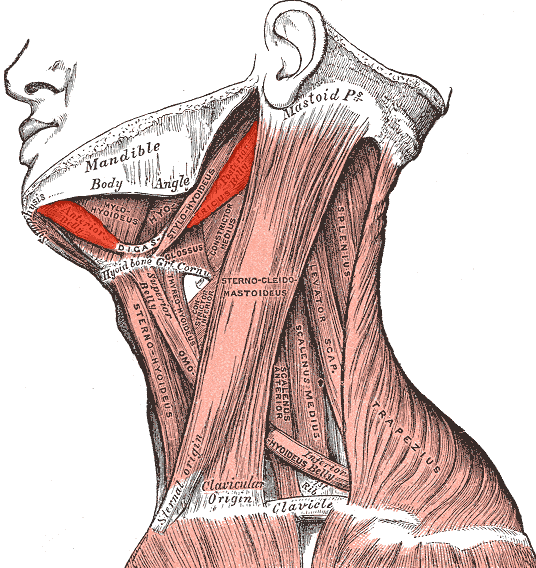
Neck Extension and Lateral Flexion
Plagued by forward head posture and phone-down eyes, the act of tilting the head back can become unnerving. Used to being underutilized, the cervical spine has to be coaxed into believing extension can be a position of comfort. The shoulders, jaw, and brain can be manipulated to convince the tissues and central nervous system that skull folding (opposite typical) is an acceptable action. Cultivating a feeling of safety creates a movement confidence that is then bold enough to take risks.
Separating the shoulder blades spreads the tissues away from the spine, and elevating the shoulders creates a pocket of resistance that the neck needs to fight against to extend:
A hiked trapezius makes this a secure isometric.
Similarly, lifting the shoulder also raises the lower attachment point. An attempt to keep the greater range of motion as the shoulder is relaxed back to ‘normal’ offers a variable position of stretch — one that pulls from the inner workings of the body instead of the distal.
I refused to change this cover frame. The fear of looking weird keeps too many from doing what is necessary. Notice the scalenes flaring up. Sometimes I like to play a morning game of ‘put on moisturizer without those razor wires popping up’. Great fun. I lack the attentional energy for it at night.
After my most recent massage, my therapist said it was my skull that was tight. Especially where the base meets the neck. The jaw also intersects there and has a tensioning mechanism for motor control. In exploring my available jaw movements, I found they were particularly wonky — jerky and jagged. The following video was taken a few weeks after I had some practice smoothing things out. I acknowledge my neck muscles bulging out near the end:
Mouth closed then mouth open, with and without the assistance of the lips. I have a slight underbite and my jaw lilts to the left. The feature/header photo shows how intertwined the jaw and neck are anatomically.
‘Brain stuff’ can be simplified to the development of movement options. Figuring out multiple ways to get to the desired outcome uses variability to assess means and defend a choice. Creating an unknown and comparing it to a known melds mind and body into a unified, sensory evaluation tool:
Shaking and bouncing can be used as another means of a neurological reset. Rhythmic tension can assist in facilitating the ‘on-off’ competency of muscles, especially when they are sourced away from from the place of stiffness:
Shoulder movements added some tugging play and dynamic feels from a different direction.
Excessive tightness, pain, or discomfort is a sign that the way you execute your movement decisions are beyond the body’s capacity to acutely adapt. They are biomarkers that certain things in certain places are bearing more of a systemic load then they can bear. Whether it is what you are doing or how you are doing it, you are receiving a signal requesting change. Honoring this alarm validates both your feelings and your right to to reconsider if the results achieved were actually desired.




Interesting article Christine. The slumping forward culture. Till we reach a point where we cannot lie on the ground anymore (without a pillow), since the tension in our neck is blatant. Where does it start, I wonder?!? Perhaps the pillow is to blame, or the head-down-deskwork. I got to know the feeling of losing the ability to just lie without a pillow to support my neck. Well, what to say…Fortunately this period is over now.
Honestly, I feel in love with this sentence: “Creating an unknown and comparing it to a known melds mind and body into a unified, sensory evaluation tool”. That I consider loving oneself, caring for oneself through physical assessment. The outcome can become so much greater.
The first and second videos are nice interventions, while sitting at the desk working. The magical 60 seconds. The last video reminded me to Rhythmic Movement Training. Have you heard about it?
If you do not mind, I will add your article to one of mine I wrote some time ago. Here is the link to it: http://christianrabhansl.de/unser-geliebtes-mobiltelefon/
In the article you will find a graph showing the force on the cervical spine at various forward head positions.
Last but not least, maybe you are interested in a Feldenkrais lesson by Buffy Owens about the jaw: https://consciousmovements.com/movements-of-the-jaw-part-1/
So far so good.
Chris
Ah! Thank you for all of this. Such great stuff. Thank you for sharing. I will have to look up Rhythmic Movement Training as the name alone has me intrigued. Super grateful 🙂